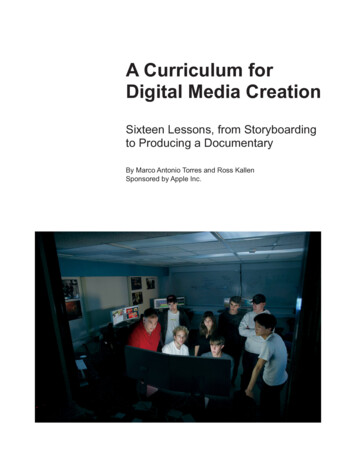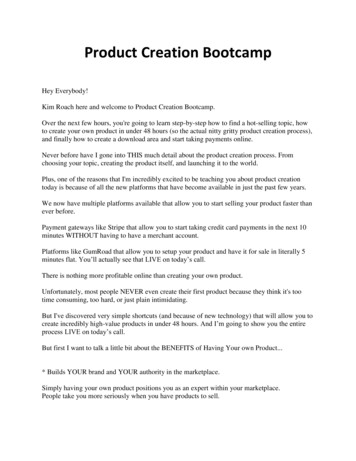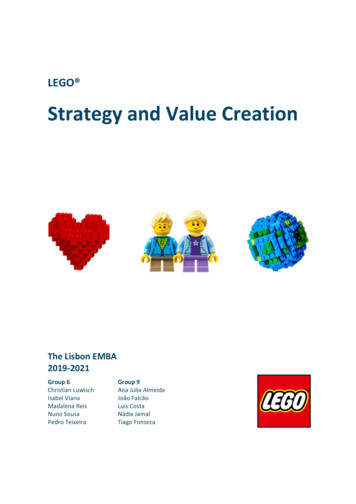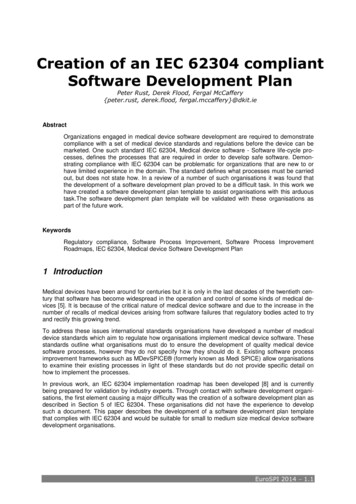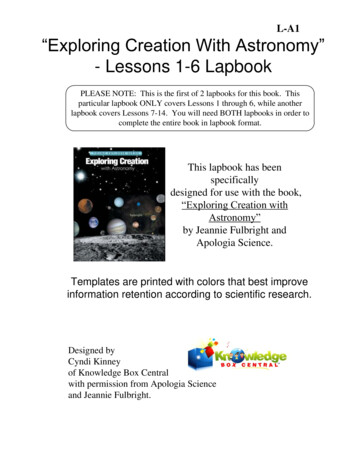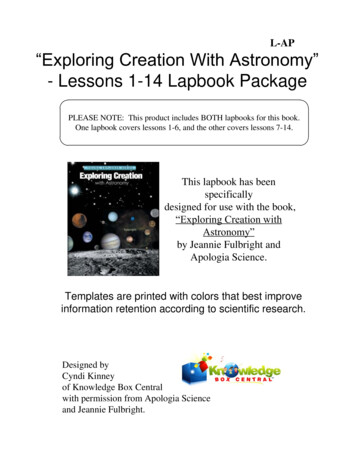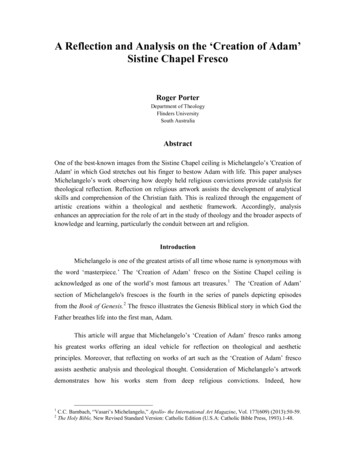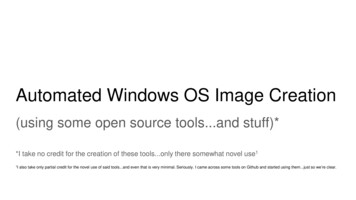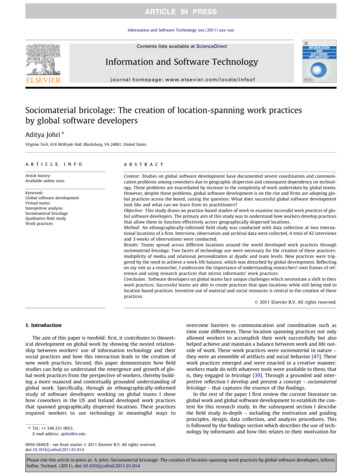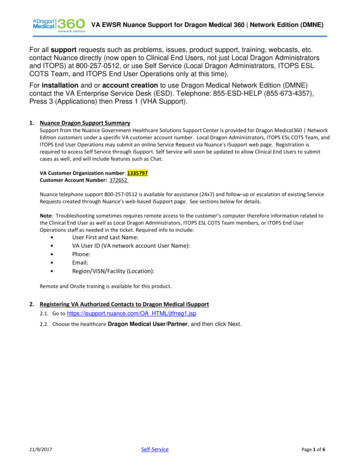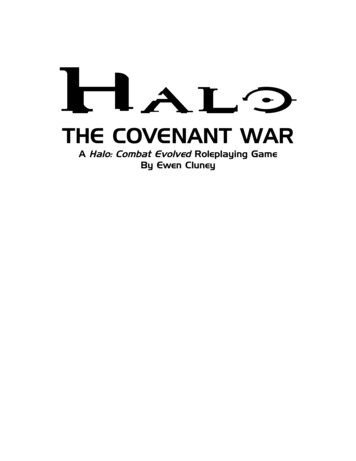
Transcription
HaloTHE COVENANT WARA Halo: Combat Evolved Roleplaying GameBy Ewen Cluney
Table of ContentsIntroduction. 3Setting Information. 3Tools of the Trade. 3Canon Cannon.4Fudge Basics. 4Not Done Yet. 5Standard Disclaimers. 5Character Creation. 6Step 1: Attributes. 6Step 2: Secondary Values. 6Step 3: Select Profession.7Step 4: Select Specialty.8Step 5: Personal Traits. 9Skill Descriptions. 10Gift Descriptions. 11Spartans. 12Rules. 14Action Resolution. 14Combat. 16Vehicles.19Fudge Points.21UNSC Equipment, Vehicles, and NPCs. 22UNSC Weapons. 22UNSC Vehicles. 24Stock UNSC NPCs. 25The Covenant. 29Covenant NPCs. 29Covenant Weapons. 35Other Covenant Equipment.38Covenant Vehicles. 39Running The Game. 43Setting Things Up. 43Freeform Character Creation. 44Video Game Physics. 442
INTRODUCTIONHalo: The Covenant War is a tabletop RPG based on Bungie’s Halo series of FPSgames. It uses a variant of Fudge, a free system created by Steffan O’Sullivan. Thecomplete rules are included here, but if you’re interested in finding out more about thesystem and its endless options you can get it online, or there’s a print version publishedby Grey Ghost Games. I went with Fudge basically because I’m intimately familiar withit and know how to make it do what I want. Character creation is radically changed fromany existing Fudge variant, and the default wounding rules are replaced with healthpoints. For more on Fudge, check out www.fudgerpg.com; there are zillions of differentvariant rules that could be plugged into this game if you’re so inclined, especially in thehardcover Fudge 10th Anniversary Edition.The design philosophy of this game is that the goal is to create a fun RPG thatcaptures the feel of the Halo games. I’ve put a lot of detail into things that matter in thevideo games; the rest you can hand-wave, make up as you go along, or reduce to simpledice rolls. Also, while it can handle other things, H:tCW is geared primarily towardsgames about UNSC marines fighting the Covenant. Fudge Points are your friend.Setting InformationHaving the fan following that it does, there are plenty of places to find referencematerial on Halo more detailed than I could ever hope to put together. This game includessome basic setting information, but if you really want the full skinny you should checkout some of the following: halo.bungie.org: This is the main fan site for all things Halo. Of particularinterest is the Story Page, which has in-depth analyses of all different aspects ofthe Halo universe. The Library: The Library is probably the single largest and most extensivecollection of information on Halo, with articles covering just about everything.http://library.psyjnir.net/ Wikipedia: The free online encyclopedia that anyone can edit is at its best whendealing with pop culture stuff, and Halo is no exception. Through numerousarticles it has a wealth of information about Halo. The main article on Halo (withmany links to secondary articles) can be found at:http://en.wikipedia.org/wiki/Halo (video game series)Tools of the TradeThere are a few things you’ll want to have in order to play this game: Paperwork: For some reason they sometimes call these “pen-and-paper” RPGs,when you really want to be using pencil and paper. Players are going to needsheets for their characters, and everyone is probably going to want scratch paperto scribble random stuff on, especially the GM. Randomizer Thingies: Since this is Fudge, there are a couple of different waysto handle what happens when a character wants to try stuff and could succeed orfail. Like a typical RPG you can use dice—six-sided, special Fudge Dice, or tensided—or you can be weird and use playing cards.3
Map Stuff: Especially for a game that emphasizes tactical combat, having somekind of map and movable figures helps a lot. I use one of those dry-erase “battlemat” things and goofy paper miniatures, but if you want to go crazy with actionfigures or cool wargame type miniatures and actual 3-D terrain, more power toyou.Canon CannonAs with any other fan activity, how close you hew to the canon continuity whenplaying this game is totally up to you. In the canon, Spartans are very much anendangered species, and having an entire squad of them as player characters isn’t exactlyplausible. That doesn’t necessarily mean it should stop you though. Your game is bydefinition not part of the official Halo continuity, so it pays to remember you can prettymuch do whatever the hell you want with it. Do you want there to be more survivingSpartan-IIs? Or a new generation of Spartan-IIIs? Or do you think it would be neat ifhumans and Elites teamed up against a common foe? Go for it.Fudge BasicsBefore we jump into the game, we need to introduce some Level Description–3Terribleof the basic elements of the Fudge system that powers H:tCW.–2PoorCharacters are defined by traits, things that describe them.–1MediocreThere are three main types of traits: Attributes, Skills, and 0FairGifts. Attributes and Skills are both rated in Levels; for 1Goodnormal humans these range from –3 to 3, where 0 is 2Greataverage1. Exceptional characters can have levels of 4 or 3Superbmore. Gifts are other beneficial traits that don’t have levels; a 4Legendarycharacter either has it or doesn’t.When a character wants to do something where the outcome is in doubt (or just whererandomness could make the game more interesting), the Action Resolution rules comeinto play. The GM names a relevant Attribute or Skill for the action and the player usessome kind of randomizer (usually dice; see p. 14) to produce a result between –4 and 4,which is added to the level of the relevant trait. The sum of the two is called the RolledDegree. If the character is acting directly against another character (an Opposed Action),the character with the higher Rolled Degree is the winner, and a tie is (usually) a tie. Ifthere is no opponent and something is just difficult (an Unopposed Action), the GM setsa Difficulty Level (a number rated in Levels, depending on how hard the action is) thatmust be matched or exceeded in order to succeed.So, supposing there are two characters, A and B, who have Close Combat at 2 and 1 respectively. A swings at B and B tries to parry; the GM has them roll dice. A rolls 1, so his Rolled Degree is 3. B rolls 0, so his Rolled Degree is 1. A beat B by 2whole points (his Relative Degree), so he wins and slugs B.On the other hand if A is just climbing a tree, the GM might decide to have him makea Body roll against a Difficulty Level of 1. Any Rolled Degree of 1 or better will lethim climb the tree.1H:tCW uses a variant of the standard Fudge rules; normally the descriptions listed in the table to the right are the traitlevels. Personally I think it’s much easier to just use the numbers.4
Not Done YetI’m intending to add more stuff to this game to make it more complete. At themoment it mostly lets you do games dealing with fighting the Covenant, but hopefullyit’ll eventually include: Proper character sheets, and reference sheet/GM screen type stuff. Stats for the stuff pertaining to the various Halo ringworlds—stats for the Flood,Sentinels, etc. Stats for some of the other stuff that’s not quite official, like the flamethrower,ATV, etc., as well as getting more thorough in including all the different variantsof the Covenant NPCs. Incorporating some more rules options, including more freeform charactercreation. Rules for running a game more in the style of Red vs. Blue. It’ll be weird. Possibly something to deal with fighters and ship-to-ship combat. It’d beannoying to do, since there’s so little to go off of from the games.Also, I’ll be putting together an adventure scenario for this game, called Halo:Weathering the Storm.I’m open to contributions by the way.Standard DisclaimersHalo: The Covenant War is, as they say on RvB, based on Halo , 1985-2001Microsoft Corporation, All rights reserved. Microsoft, Bungie, and Halo are trademarksof the Microsoft Corporation.The following materials based on FUDGE, entitled Halo: The Covenant War, arecreated by Ewen Cluney, and are not authorized or endorsed in any way by SteffanO’Sullivan or any publisher of other FUDGE materials. Neither Steffan O’Sullivan or anypublisher of other FUDGE material is in any way responsible for the content of thesematerials. Original FUDGE materials 1992-1995 Steffan O’Sullivan, All Rights Reserved.If you wish to distribute copies of all or portions of F UDGE or derivative works basedon FUDGE for a fee or charge, other than in a magazine or other periodical, you must firstobtain written permission from:Steffan O’SullivanP.O. Box 465Plymouth, NH 032645
CHARACTER CREATIONCharacter creation in Halo: The Covenant War is intended to be quick, simple, andpainless. It favors picking out templates over free-form selection of traits, mainly to savetime that could be spent killing aliens. Player characters are assumed to be normalhumans, often marines; if you want to create Spartans as player characters, see p. 12. Ifyou want to go nuts and have Elites, see p. 33.Step 1: AttributesCharacters have four attributes, Body, Perception, Reflexes, and Will. Each of thesestarts out at 0; you have 4 levels to assign as you wish. You can reduce an attributebelow 0 (to a minimum of –3) to have points to put into another attribute, but keep inmind that there are no unimportant attributes. No single attribute can go above 3 ifyou’re a normal human.Body is a character’s overall physical conditioning: strength, stamina, andBodycapacity for punishment.Perception Perception is vitally important on the battlefield; what you can or can’tsee can make the difference between life and death.When you need to react quickly, whether it’s leaping out of the way ofReflexesincoming fire or just pushing a button faster than the other guy, Reflexesis the attribute you use.Will represents your character’s mental fortitude. It’s used for things likeWillkeeping calm under fire, not being fast-talked, and resisting torture.Attributes and SkillsUnlike your typical RPG, in Fudge attributes and skills aren’t numericallycombined. In fact they’re completely independent of each other, though you’reencouraged to select traits that make sense together. In Halo: The Covenant Warattributes and skills mostly cover different, unrelated things. Shooting and pilot
playing this game is totally up to you. In the canon, Spartans are very much an endangered species, and having an entire squad of them as player characters isn’t exactly plausible. That doesn’t necessarily mean it should stop you though. Your game is by definition not part of the official Halo continuity, so it pays to remember you can prettyFile Size: 375KBPage Count: 45
